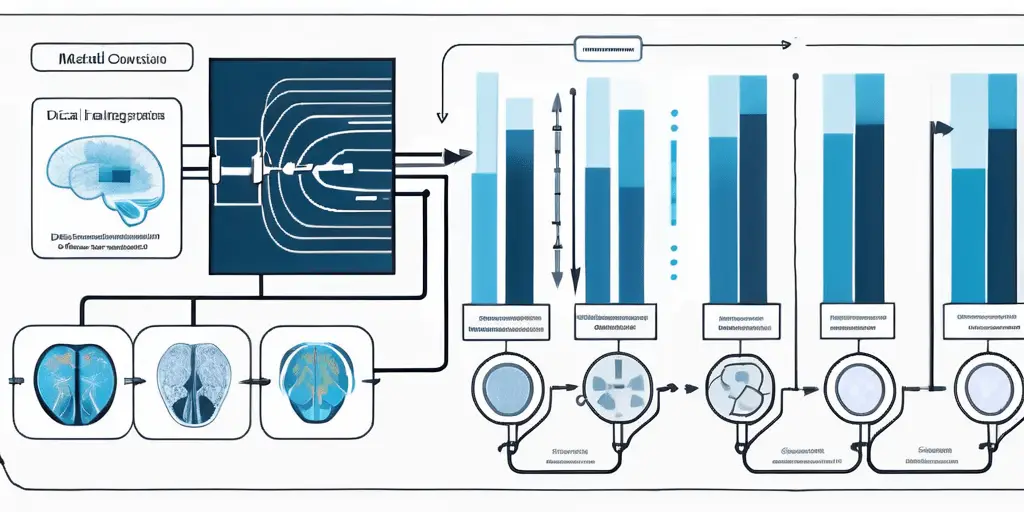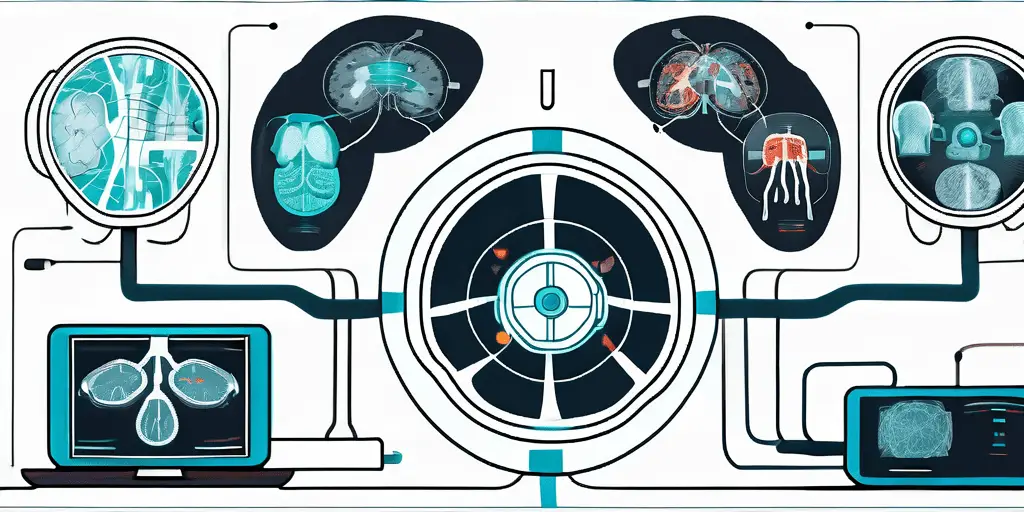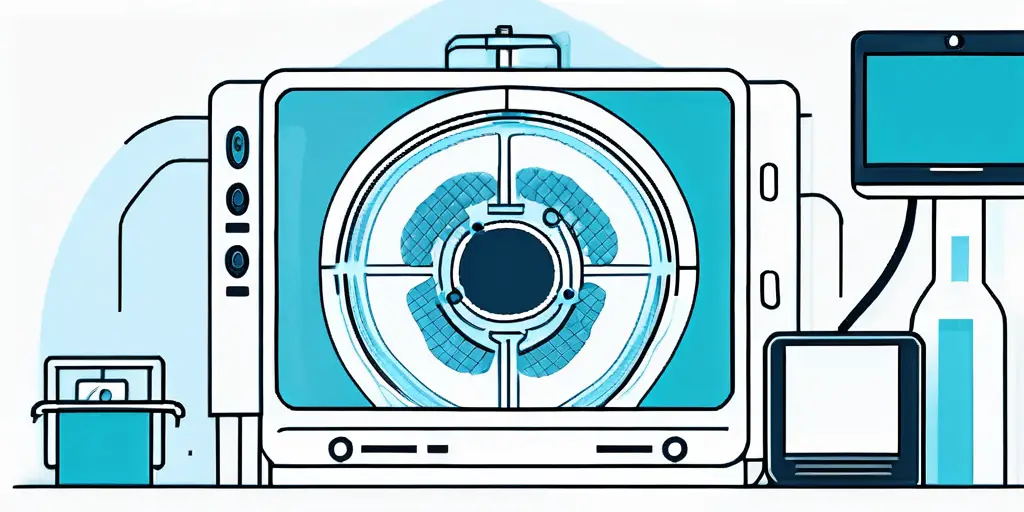Updated November 16, 2024
DICOM, which stands for Digital Imaging and Communications in Medicine, is a widely used standard in medical devices. It plays a crucial role in seamlessly exchanging and managing medical images and other healthcare-related data. In this comprehensive guide, we will delve into the basics of DICOM, its technical aspects, its role in different medical devices, the benefits of using DICOM, the challenges in implementing it, and the future trends in DICOM technology.
Understanding the Basics of DICOM
DICOM is a standard that defines the format and communication protocols for the secure and efficient transmission of medical images and associated information. It enables interoperability between different medical devices, such as imaging devices, monitoring devices, and more. With DICOM, medical professionals can easily access, share, and analyze patient data, regardless of their device or software.

One of DICOM’s key features is its ability to store not only images but also non-image data, such as reports, annotations, and measurements. This comprehensive approach allows for a more holistic view of a patient’s medical information, facilitating better-informed decision-making by healthcare providers.
Defining DICOM in Medical Devices
DICOM is primarily used in medical imaging devices, such as X-ray machines, MRI scanners, CT scanners, and ultrasound machines. It allows these devices to produce digital images and import them into a standardized format, ensuring compatibility and consistency across different systems. DICOM also includes metadata, such as patient information, acquisition details, and image annotations, making it a comprehensive solution for medical imaging.
DICOM supports various image types, including 2D, 3D, and even 4D images, enabling healthcare providers to capture and analyze complex medical data with precision. This versatility makes DICOM indispensable in various medical specialties, from radiology and cardiology to oncology and orthopedics.
The Importance of DICOM in Healthcare
The adoption of DICOM in healthcare has revolutionized how medical images are stored, shared, and analyzed. By providing a common language for medical devices, DICOM eliminates data silos and enables smooth communication between healthcare providers. This improves patient care, accurate diagnosis, and collaboration among healthcare professionals.
DICOM’s standardized format enhances data security and integrity, ensuring patient confidentiality and regulatory compliance. Healthcare organizations can rely on DICOM to maintain the privacy of sensitive medical information while facilitating seamless data exchange for clinical decision-making and research purposes.
The Technical Aspects of DICOM
DICOM employs various technical components and features to ensure the seamless exchange of medical data. Understanding these technical aspects is crucial for effectively implementing DICOM in medical devices.
One crucial aspect of DICOM is its utilization of unique identifiers known as UIDs (Unique Identifiers). These UIDs are vital in ensuring that medical images and associated data are uniquely identified and can be accurately tracked throughout the healthcare system. By assigning UIDs to different elements within the DICOM standard, such as studies, series, and instances, interoperability between various systems and devices is greatly enhanced.
How DICOM Works in Medical Devices
At its core, DICOM uses a network communication protocol known as TCP/IP to transmit medical images and associated data. It also defines a specific file format, known as the DICOM file format, which stores images and metadata in a standardized manner. DICOM devices, such as imaging machines or workstations, communicate using DICOM services and commands, allowing them to exchange and manipulate medical data efficiently.
DICOM incorporates modality worklists, enabling seamless integration between imaging devices and Radiology Information Systems (RIS). By utilizing modality worklists, imaging devices can receive pertinent patient information and examination details directly from the RIS, streamlining the imaging workflow and reducing the likelihood of data entry errors.
Key Features of DICOM
DICOM has several key features that make it an indispensable standard in the healthcare industry. Firstly, it ensures the consistency of medical data by establishing standardized templates for different medical image types. Secondly, DICOM provides robust security mechanisms, including authentication and encryption, to protect patient data during transmission. Lastly, DICOM supports the efficient compression of medical images, reducing storage requirements and facilitating faster data transfer.
DICOM’s structured reporting capabilities allow for the standardized representation of textual information in a structured format within the image header. This structured approach enables healthcare providers to access and interpret diagnostic reports, enhancing communication and decision-making processes. Additionally, DICOM incorporates the concept of hanging protocols, which define how medical images should be displayed for interpretation. By utilizing hanging protocols, healthcare professionals can customize the layout of images based on their preferences, optimizing workflow efficiency and clinical productivity.
The Role of DICOM in Different Medical Devices

DICOM in Imaging Devices
Imaging devices, such as X-ray machines, MRI scanners, and CT scanners, heavily rely on DICOM for seamless image acquisition, storage, and sharing. DICOM’s standardized format ensures that medical images captured by these devices are of high quality and can be easily interpreted by healthcare professionals. Moreover, DICOM enables the transmission of these images to other DICOM-compliant systems, facilitating efficient collaboration among healthcare providers. This interoperability not only streamlines the diagnostic process but also supports treatment planning and ongoing monitoring of patients across different healthcare facilities.
DICOM in Monitoring Devices
While DICOM is commonly associated with imaging devices, its utility also extends to monitoring devices. Patient monitors, pulse oximeters, and electrocardiograms (ECGs) can integrate DICOM to transmit vital signs and real-time patient data to electronic health record (EHR) systems or other DICOM-compatible devices. By leveraging DICOM standards, these monitoring devices ensure the seamless exchange of critical patient information, enabling healthcare providers to make informed decisions promptly. This integration enhances the accuracy and timeliness of patient monitoring, ultimately improving the quality of care delivered to patients.
Adopting DICOM in monitoring devices promotes interoperability within healthcare systems, allowing for a more comprehensive approach to patient care. By standardizing data exchange and communication protocols, DICOM facilitates the integration of diverse medical devices and systems, creating a cohesive network that supports holistic patient management. This interconnected ecosystem enhances clinical workflows and paves the way for advancements in telemedicine and remote patient monitoring, expanding access to quality healthcare services.
The Benefits of Using DICOM in Medical Devices
Implementing DICOM in medical devices offers numerous benefits that positively impact patient care, healthcare operations, and overall efficiency in the healthcare industry.
Improving Patient Care with DICOM
DICOM enables healthcare professionals to access patient data and medical images from any DICOM-compliant device or system. This accessibility facilitates quick and accurate diagnosis, as doctors can view and compare images from multiple modalities and time points. Consequently, patients receive more precise treatments, improving outcomes and a higher quality of care.
Streamlining Healthcare Operations with DICOM
The adoption of DICOM in medical devices streamlines healthcare operations by enabling seamless data exchange and integration. DICOM-compliant devices can easily integrate with Picture Archiving and Communication Systems (PACS), Electronic Health Record (EHR) systems, and other healthcare IT solutions. This integration eliminates the need for manual data entry, reduces errors, and enhances workflow efficiency, allowing healthcare providers to focus more on patient care.
Using DICOM standards in medical devices promotes interoperability across healthcare facilities and systems. This interoperability ensures that patient data and medical images can be shared securely and efficiently between healthcare providers, regardless of the technology or vendor used. This seamless exchange of information improves collaboration among healthcare professionals and enhances patient care continuity, especially in cases where they may require treatment from multiple specialists or facilities.
Enhancing Data Security and Privacy
Another significant advantage of incorporating DICOM in medical devices is enhancing data security and patient privacy. DICOM standards include robust encryption protocols and access controls that protect sensitive patient information from unauthorized access or breaches. By adhering to DICOM guidelines, healthcare organizations can ensure the confidentiality and integrity of patient data, maintaining compliance with regulatory requirements such as HIPAA.
Challenges and Solutions in Implementing DICOM

Implementing the DICOM standard in a healthcare setting involves a complex network of medical devices, imaging equipment, and information systems. Each device may have unique specifications and configurations, leading to compatibility issues when establishing seamless communication. This intricate web of interconnected technologies requires careful planning and execution to ensure successful DICOM integration.
Common Issues with DICOM Integration
One common challenge faced during DICOM integration is ensuring compatibility between different versions and implementations of the DICOM standard. Data mapping and interoperability issues may also arise when integrating DICOM devices with non-DICOM-compliant systems. These challenges can hinder the seamless flow of medical data and affect the efficiency of healthcare workflows.
The sheer volume and variety of medical imaging data generated by DICOM devices pose a significant challenge for storage and retrieval. Healthcare organizations must implement robust data management strategies to handle large datasets efficiently while ensuring quick access for healthcare providers.
Overcoming DICOM Implementation Challenges
Healthcare organizations can adopt robust DICOM software libraries and development tools to overcome these challenges. These tools provide compatibility across different DICOM versions and simplify the integration process. Additionally, thorough testing and validation of DICOM integrations can ensure data accuracy and smooth data exchange between devices and systems.
Establishing clear communication channels between IT teams, healthcare professionals, and device manufacturers is crucial for successful DICOM implementation. Collaboration and knowledge sharing among stakeholders help address technical issues promptly and streamline the integration process, ultimately improving patient care and clinical outcomes.
The Future of DICOM in Medical Devices
DICOM (Digital Imaging and Communications in Medicine) continues to evolve, adapting to advancements in medical technology and driving innovation in healthcare. Let’s explore some emerging trends and the potential impact of AI and machine learning on DICOM.
Emerging Trends in DICOM Technology
With the increasing adoption of cloud computing and the Internet of Things (IoT) in healthcare, DICOM is expected to play a vital role in integrating these technologies. DICOM web services and APIs will enable seamless connectivity and data exchange between medical devices, cloud platforms, and AI-driven applications.
Imagine a scenario where a patient’s medical devices, such as a smartwatch or a wearable health monitor, continuously collect data about their vital signs. Through DICOM, this data can be transmitted securely to a cloud platform, where AI algorithms can analyze it in real-time. This analysis can provide valuable insights into the patient’s health status, allowing healthcare providers to intervene promptly if abnormalities are detected. By leveraging DICOM’s interoperability capabilities, medical devices can harmonize, creating a comprehensive healthcare ecosystem.
The Impact of AI and Machine Learning on DICOM
AI and machine learning have the potential to revolutionize medical imaging and analysis. With its standard format and metadata, DICOM provides a fertile ground for AI algorithms to analyze large volumes of medical data with high accuracy. AI-powered solutions can aid in automated image recognition, diagnosis assistance, and treatment planning, leading to faster and more precise healthcare interventions.
Consider a radiologist using DICOM-compatible software that incorporates AI algorithms. As the radiologist reviews a medical image, the software can analyze the image in real-time, highlighting potential areas of concern or anomalies that may require further investigation. This AI-assisted analysis not only saves time but also enhances the accuracy of diagnosis, reducing the chances of missed or misinterpreted findings. With the continuous advancement of AI and machine learning, the potential applications of DICOM in medical devices are boundless.
Conclusion
DICOM is a comprehensive standard that plays a vital role in exchanging and managing medical images and associated data in medical devices. By understanding the basics, technical aspects, and role of DICOM in different devices, healthcare professionals can harness its benefits to improve patient care and streamline healthcare operations. While challenges exist in implementing DICOM, adopting appropriate tools and addressing interoperability issues can ease integration. DICOM is poised to embrace emerging technologies and become an enabler for AI-driven healthcare solutions, shaping the future of medical devices and patient care.
As you navigate the complexities of DICOM in medical devices and the evolving landscape of healthcare technology, the importance of robust cybersecurity cannot be overstated. With our expertise in medical device cybersecurity and compliance, Blue Goat Cyber ensures that your systems are protected against cyber threats. Our veteran-owned business is dedicated to providing top-tier B2B cybersecurity services, including penetration testing and HIPAA compliance. Don’t let cybersecurity concerns hold you back from leveraging the full potential of DICOM and AI in your medical devices. Contact us today for cybersecurity help and partner with a team that is as passionate about securing your business as you are about improving patient care.
